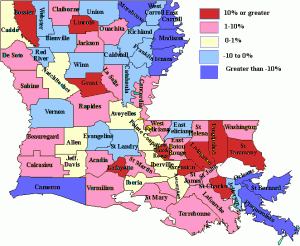Overall, the Census showed that Louisiana’s population increased 1.4% between 2000 and 2010. As expected, the 2005 hurricanes (Katrina and Rita) initiated a significant outflow of population from Metro New Orleans – the city of New Orleans lost 29% of its population and now only has 344,000 residents. Jefferson Parish lost 5% of its population and now has 433,000. These population losses from the (formerly) two largest parishes now means that East Baton Rouge Parish, with 440,000, is the most populous parish in Louisiana.
While the parishes (Orleans, St Bernard, Plaquemines, and Cameron) with the most significant hurricane damage lost between 14% and 47% of its people, the other story of the 2010 Census was the accelerated growth of New Orleans and Baton Rouge’s suburbs. Livingston and Ascension Parishes each saw a 40% growth in population over the last decade. St Tammany also continued to boom with 22% population growth, and Tangipahoa posted 20% growth. Below is a graphical depiction of the changes that have occured in each parish over the past decade:
What will the implications of these population changes have on redistricting ? Let’s start with the US House delegation. Louisiana’s loss of a House seat means that all districts need to expand to have the appropriate population. Rep. Cedric Richmond’s district in New Orleans needs to add about 262,000 people, which means that his district will need to stretch up the Mississippi river. While Rep. Bill Cassidy’s district is, on the surface, the least impacted (it only needs to pick up 28,000 people), district adjustments needing to be made to Richmond’s district will almost certainly impact Cassidy and Jeff Landry’s districts.
The real impact of New Orleans’ population loss will be felt in legislative reapportionment, since the membership of the state House and state Senate is not shrinking. The Census numbers suggest that the following gains/losses would occur throughout the state:
(1) Orleans/Jefferson/St Bernard – loss of 5 House seats and 2 Senate seats
(2) The fast growing suburbs along I-10/12 (St Tammany, Tangipahoa, Livingston, Ascension, and St Charles) – gain of 3 House seats and a Senate seat
(3) East Baton Rouge and Lafayette Parishes would each gain 0.5 House seats and 0.2 Senate seats
(4) North/Central Louisiana would gain 0.5 House seats and 0.2 Senate seats. This is a huge turnaround from prior reapportionments, when this part of the state steadily lost legislative representation.
(5) The remainder of the state would gain 0.4 House seats and 0.1 Senate seats
The largest Senate district, population-wise, was that of Jody Amedee (D-Gonzales), whose district has 157,000 residents (40,000 more than needed). Cynthia Willard-Lewis (D-New Orleans) saw her district in the 9th Ward of New Orleans lose 50,000 people, and now has the smallest Senate district, with 66,000 people. The largest House district is that of Eddie Lambert (R-Prairieville), with 66,000 people. The Lower 9th Ward district of Charmaine Stiaes (D-New Orleans) only has 16,000 residents now. To put these numbers in perspective, an ideal House district has 43,175 people, while the ideal Senate district needs 116,240 people.


[…] Original Source Comments (0) […]
[…] Found From Source VN:F [1.9.6_1107]please wait…Rating: 0.0/10 (0 votes cast)VN:F [1.9.6_1107]Rating: 0 (from 0 votes) This entry was posted in Uncategorized. Bookmark the permalink. ← Free Solar Energy Blog Archive Islamic Socialism , Nadin Khoury … […]
[…] Source Found Here […]
[…] reading at WinWithJMC.com. Tagged with: Census Louisiana blog comments powered by Disqus […]
Sites we Like……
[…] Every once in a while we choose blogs that we read. Listed below are the latest sites that we choose […]……
Websites we think you should visit…
[…]although websites we backlink to below are considerably not related to ours, we feel they are actually worth a go through, so have a look[…]……
Websites worth visiting…
[…]here are some links to sites that we link to because we think they are worth visiting[…]……
Websites you should visit…
[…]below you’ll find the link to some sites that we think you should visit[…]……
Websites we think you should visit…
[…]although websites we backlink to below are considerably not related to ours, we feel they are actually worth a go through, so have a look[…]……
Recommeneded websites…
[…]Here are some of the sites we recommend for our visitors[…]……
Sites we Like……
[…] Every once in a while we choose blogs that we read. Listed below are the latest sites that we choose […]……
Online Resource…
[…]The information mentioned in the article are some of the best available […]……
Recent Blogroll Additions……
[…]usually posts some very interesting stuff like this. If you’re new to this site[…]……